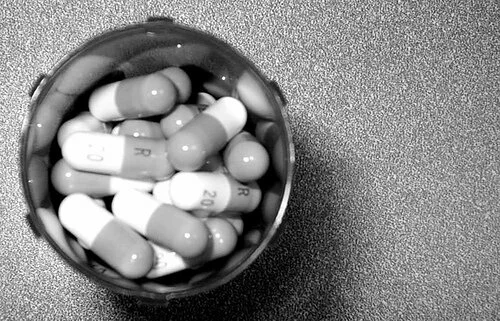It’s time to put an end to our “prescription drug culture”
I stumbled across this while reading Gawker: “Teen socialite” Peaches Geldof says the staff at the fashion magazine Nylon prefer prescription drugs over illegal drugs –
What’s the drug of choice at Nylon? “Klonopin.†Peaches was definitely the talky one. Why? “It’s just a very large prescription drug culture. 
This confirms our highly anecdotal evidence of Klonopin as a mini-trend for the creative underclass, maybe better than Xanax—not that our shrink is offering to prescribe us any despite repeated inquiries.
Klonopin, classified as a “sedative-hypnotic,” is prescribed for epilepsy, panic and anxiety disorders, restless legs syndrome and other medical conditions. Unfortunately, such drugs are too easily obtained by young people, who often start taking them by raiding their parents’ medicine cabinets.
As Ritch Wagner of Purdue Pharma (OxyContin), who educates medical professionals and law enforcement officials about the dangers of prescription drug abuse, describes the growing problem:
More prescription drugs are creeping up the list of the 20 most widely abused substances, Wagner said, including the painkiller hydrocodone and methadone, a narcotic commonly used to treat heroin addiction that is now used to treat pain.
Abusers are beginning to learn it can “be more advantageous” to use prescription drugs to get high than drugs such as meth, cocaine and heroin. They are easier to obtain, and people think they are safe because doctors prescribe them.
“In my day and age, it was how many of Dad’s beers we can sneak out of the fridge,” Wagner said. “Now, it’s how many pills can I get out of the medicine cabinet.”
Wagner said children are taking whatever pills they can get their hands on, throwing them into a bowl and taking a handful. They’re called punch-bowl or grab-bag parties.
I think what really struck me about these stories was Geldof’s use of the term “prescription drug culture.” I hadn’t heard the term before.
My immediate reaction was to compare it to the “drug culture” of the ’60s and early ’70s, which we relate to young people — specifically, “hippies.” But upon reflection, the “prescription drug culture” isn’t confined to the young in our country today. It’s pervasive.
It starts with the billions of dollars in advertising that pharmaceutical companies spend to get us to stock our medicine cabinets with drugs — drugs that we might or might not really need.
Before the recent advertising campaign, for example, I’m guessing you’d never even heard of restless legs syndrome — let alone gone to the doctor and asked for Klonopin or Mirapex. The medical use of drugs like Xanax and Prozac have gone through the roof among adults of all ages. And don’t you suspect the Viva Viagra! advertising campaign has made Viagra an object of curiosity not only among middle-aged men, but among teenage boys?
When a teenager’s parents, as well as all of his or her friends’ parents, are stocking the medicine cabinet with these drugs, don’t you think what happens next is almost inevitable?
So, how do we solve the problem? Frankly, as I’ve stated here before, I would put an end to direct-to-consumer advertising by pharmaceutical companies.
Others may disagree with this approach, and that’s fine. But however we get there, we need to reach a point where we don’t expect a “pill for every ill.” Because if you believe there’s a pill for every ill, it’s a short step to believe that prescription drugs are the answer for everything — including having a good time at a party.







-
-
Search Blog Posts
-
Save Even More Money!
-

-
Trending Content
-
Watch our YouTube Video
-
Categories
Big Pharma Buy prescriptions online Canadian drugs Drug costs Drug reimportation Drug safety eDrugSearch.com FDA Health 2.0 Healthcare100 Healthcare blogs Healthcare solutions Low-cost drugs Medicare Part D Merck Online pharmacies Online pharmacy safety Pfizer Pharma bloggers Pharmaceutical companies Pharmaceutical marketing Pharma cheerleaders Prescription drug abuse Prescription drug prices Prescription drugs Prescriptions Wal-Mart drug plan -
Blogroll
- Bullet Wisdom
- Bulverde Business Directory
- Christian Counseling San Antonio Tx.
- Christian Schools in San Antonio Texas
- Christian Social Network
- Christians United for Israel
- DrugWonks.com
- Eye on FDA
- GoozNews
- Health 2.0
- Hunting Forum
- In the Pipeline
- Jesus Christ Our King
- John Hagee Ministries
- Kevin, M.D.
- Local Search Marketing
- My $299 Website
- Pharm Aid
- Pharma Marketing
- PharmaGossip
- Pharmalot
- San Antonio Asphalt
- San Antonio Life Insurance
- San Antonio Pressure Washing
- Storage New Braunfels Tx
- Texas Wildlife Supply
- The Angry Pharmacist
- The Health Care Blog
- The Peter Rost Blog
- World Vision
-
Tags
big pharma Canadian drugs canadian pharmacies canadian pharmacy consumer reports craig newmark divine healing Drug costs drug prices Drug reimportation eDrugSearch.com FDA Fosamax Generic drugs healing scriptures Health 2.0 healthcare reform Hypertension Jehova Rophe Jesus Christ Lipitor Metformin miracles nabp online pharmacy dictionary online prescriptions osteoporosis peter rost Pharmacies pharmacists pharmacychecker pharmacy spam phrma Prescription drugs prescription medication Proverbs 3:5-8 reimportation relenza Roche saving money SSRI swine flu Tamiflu The Great Physician The Lord our Healer -
Recent Tweets
- eDrugSearch Blog Rank on the Healthcare100: http://t.co/VJprL4LZWl [#]
- New blog posting, How to Get Prescription Medication Without Health Insurance - http://t.co/1ZdLavB87d [#]
- 10 Tips for Safer Prescription Drug Use http://t.co/GFnMIN1mCy [#]
- New blog posting, How to Beat High Drug Prices By Comparing Low Cost Pharmacies - http://t.co/fsZ0stNZme [#]
-
Archives
-
Recent Comments
- Heather Sturges on What is the Difference Between Effexor and Cymbalta?
- Lupe Machol on Cost of diabetes drugs has nearly doubled
- Manpower For Hospital In Pune on Why is Medicine Cheaper in Canada?
- Jen on How a Canadian Pharmacy Can Help You Offset Drug Price Hikes
- nino iarajuli on Vending machine dispenses prescription drugs
